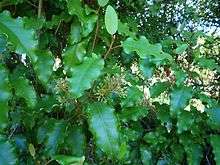Olearia paniculata
Olearia paniculata, commonly called akiraho, is a species of shrub or tree in the family Asteraceae, found only in New Zealand. The tree can grow to 6 metres high, and has yellow-green, oval-shaped leaves, with white undersides and wavy margins.
| Olearia paniculata | |
|---|---|
 | |
| Scientific classification | |
| Kingdom: | |
| (unranked): | |
| (unranked): | |
| (unranked): | |
| Order: | |
| Family: | |
| Tribe: | |
| Genus: | |
| Species: | O. paniculata |
| Binomial name | |
| Olearia paniculata (J.R.Forst. & G.Forst.) Druce | |
| Synonyms | |
|
Shawia paniculata J.R.Forst. & G.Forst. | |
O. paniculata produces clusters of daisy flowers in late autumn.[1]
Description
Olearia paniculata is a small evergreen tree that is indigenous and commonly found in both the North and South Islands of New Zealand[2]. It has reddish twigs bearing very smooth and wavy-edged oval green leaves that are white underneath and twigs that are grooved on the top surface and angular in cross-section[3]. Olearia paniculata is a tree that can grow tall to about 6 meters tall[4]. Olearia paniculata branchlets are grooved, sharp-cornered, very short and grow up to short lengths such as 2-4 centimeters [4]. Flowers are small, white, and in dense clusters[3]. Petiole of the akiraho plant which exists as a stalk that attaches the leaf blade to the stem which grows up to 5 millimeters long[4]. It also has a white thin appressed white to buff tomentum below[4]. Olearia paniculata also has a sweet smell to it and is looked at by many people as used for creating hedges[5]. The genus is named after Johann Gottfried Olearius, a 17th-century German scholar and author of Specimen Florae Hallensis.[6]. Paniculata, on the other hand, means “Small sprayed”[3]. Olearia paniculata leaf margins can be flat or strongly wavy[4].
Range
Natural global range
Olearia paniculata is endemic to both the North and South Islands of New Zealand [2].
Habitat
Olearia paniculata is most likely to be found in non-local seed sources[7]. The habitat includes a large amount of grass (c. 50% cover), with c. 3-m-tall plantings in clumps up to 5 m2. Akiraho is also commonly found around other shrubs, herbs, and ferns that are common on the forest floor[7]. It is suited to dry soils and windy places which make it common in coastal areas[8]. This species is not found in the naturally regenerating mature forest[7]. Prefers full sun to partial shade with well-draining soil. Coastal conditions and dry windy situations, so it does not drown and kill the plant[2]. It also tolerates moderate frosts but does not tolerate saturated soils[2].
Ecology
Life cycle/Phenology
Olearia paniculata produces clusters of daisy flowers in late autumn[3]. Akiraho is a plant that grows well after autumn rains as the soil is preferably soft and moist and warm which allows it to become well established before the winter season[9]. Akiraho goes into the flowering stage between the months of March and May and goes into the fruiting stage between the months of April and July[4].
Diet and foraging
Olearia paniculata the evergreen shrub or tree, does need water to eat and grow but not too much water [10]. With the leaf density of the evergreen plant, it can be important in promoting durability, water conservation, and protection from predators[10]. The kinds of soil Olearia paniculata prefer is the soil after the autumn season rains as during this stage the soil is moist and warm which is just good for the species because it allows it to establish[9]. It is important to plant Olearia paniculata into slightly raised beds of well-cultivated soil. Because this will create drainage that provides near-surface roots with aerated soil in which to grow[9]. Like all other young plants, they require thorough watering during dry times over the first two or four years mulching which helps to better conserve moisture and suppress weeds[9]. Often when Olearia paniculata is mixed with coarse sand, compost, or organic material it improves the soil's health and moisture structure[9]. When planting Akiraho it is essential to ensure the root ball is saturated and when digging the hole make sure it is twice the diameter of the root ball and watered once being planted[9].
Predators, Parasites, and Diseases
Olearia paniculata has no known pests or diseases. However, predators such as goat, cattle and sheep would consider this plant a meal [3].
Other information
Akiraho plant has sweet-smelling flowers[5]. Pruning is not normally required for this plant when planted unless it is being planted as a hedge that’s when it will require regular trimming to encourage growth[2].
References
- "Olearia paniculata". Hebe Society. Retrieved 29 May 2012.
- Corbett, Young, & Wilson (1964). "Extractives from the bark of Olearia paniculata. Australian Journal of Chemistry". Australian Journal of Chemistry. 17 (6): 712–714. doi:10.1071/CH9640712. Retrieved 10 April 2020.CS1 maint: multiple names: authors list (link)
- "Olearia paniculata". New Zealand Plant Conservation Network. Retrieved 9 April 2020.
- Forst & Forst. "NZ flora". NZ flora. Retrieved 9 April 2020.
- "Landcare Research". Landcare Research Manaaki Whenua. Retrieved 11 April 2020.
- Moench, Conrad. 1802. Supplementum ad Methodum Plantas. pp. 254-255
- Reay & Norton (1999). "Assessing the success of restoration plantings in a temperate New Zealand forest". Restoration Ecology. 7 (3): 298–308. doi:10.1046/j.1526-100X.1999.72023.x.
- Canterbury Native Plants. "Motukarara Conservation Nursery Plant List" (PDF). Department Of Conservation. Retrieved 5 April 2020.
- Campbell, D.J (2002). "Changes in numbers of woody plant seedlings on Kapiti Island after rat eradication" (PDF). Wellington,, New Zealand: Department of Conservation: 28.
- Mooney & Dunn (1970). "Photosynthetic systems of Mediterranean-climate shrubs and trees of California and Chile". The American Naturalist. 104 (939): 447–453. doi:10.1086/282679. JSTOR 2459313.
| Wikimedia Commons has media related to Olearia paniculata. |
| Wikispecies has information related to Olearia paniculata |